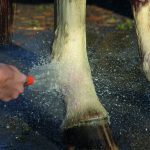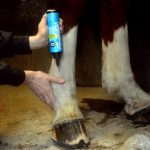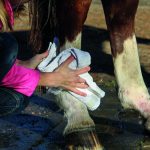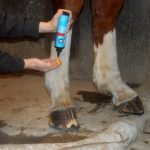Mud fever treatment
Mud fever is a secondary infection with primary causative problem. These could be e.g. sun burned skin (white socks), over softened skin in wet weather and cuts. Mud fever results from situations where the ability of skin to defend from external pathogens is reduced.
Veterinarian can best analyse the comprehensive clinical situation and define the right treatment.
In mud fever there is an overgrowth of microbes on the skin and this can invade the skin tissue due to decreased skin condition. Often the causative microbe is Dermatophilus congolensis, an anaerobic bacteria. In the worst case the bacteria invades into deeper skin tissue and the infection spreads from local to systemic. This can be seen in swelling and warmth, which can lead to cellulitis/lymphangitis.
When topical treatment alone is not sufficient, ask your veterinarian to evaluate the need for systemic antimicrobic medication. Scabs are often seen in mud fever. These scabs are very infective and protects the causative microbe. These scabs are outside the blood circulation and thus not curable by systemic antimicrobic medication. Hence, the scabs require effective topical treatment.
Please note, that vaseline and parafine based products improve the conditions for anaerobic bacteria, which is not desired.
Mud fever is often very painful for the horse and the treatment requires extra cautions and respect for the horses pain. If needed the treatment is started under sedation.
PRINT PDF INSTRUCTIONS:
Below step by step instructions for use of SOLHEDS products
1. The affected area needs to be clipped in case of a very hairy horses. Veterinarian often does this under sedation. The target is to provide air to the skin and reduce the conditions for the anaerobic microbes.

2. Rinse all dirt and wet the affected area carefully.

3. Apply Derma1 skin care shampoo carefully on affected area.
4. Leave Derma1 shampoo for at least 5 minutes. Longer leave in time enhances the efficacy.

5. Rinse the shampoo while very carefully trying to loosen the scabs. Only remove scabs which detach easily. Too aggressive tearing of the scabs only makes the situation worse.
6. Dry the area carefully with clean towel. Apply Derma5 Germ Fighting Cream on dry skin. Apply the cream carefully on scabs and on surrounding skin. Derma 13 zinc solution cream is optimal choice for infections with excudate or when managing skin fold infections.

7. Repeat the treatment daily and if possible, twice a day during the first few days. Derma5 cream softens the scab and ease the detaching of the scabs. Please note that the scab is highly infective and need to be disposed carefully. The affective area decreases daily.
8. Continue this until the scabs are worn out. After the scabs are detached continue the treatment for 2 days. Derma2 calming serum provides additional therapy for reconditioning of the skin after injury and renewal of hair growth.

9. Monitor the affected areas carefully and start the treatment early, before extensive scabs. Early diagnosed mud fever can be managed with Derma1 skin care shampoo and Derma2 serum.
NB. Antimicrobic treatment should not be interrupted too early, as it could worsen the infection and make the microbes resistant to antimicrobic treatment. Mixing or using various products only few days to treat the infection can have similar effect.

Mud fever can develop into a chronic problem. It can also spread e.g. from pastern to body. Local infections are treated topically and systemic infections with systemic medication.
Best treatment for the disease is to understand and avoid the primary problem.
Early diagnosis and treatment are important. Check the risk areas regularly during daily care of your horse.


